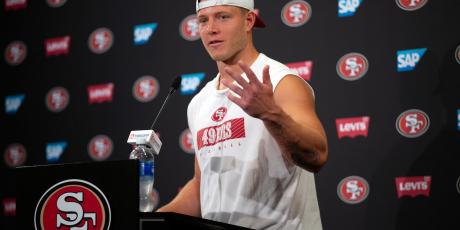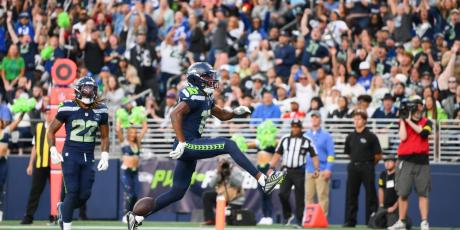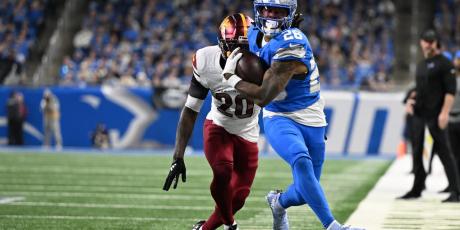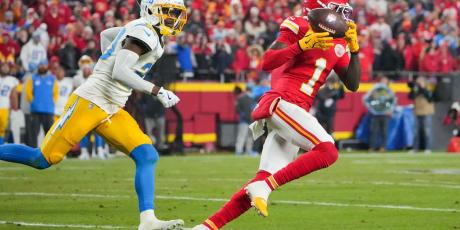Is Carlos Hyde Good Enough to Win Over Kyle Shanahan?

Last year, I said “there are exceptions to every rule” when talking about Carlos Hyde, but he may have to overcome even more situational dysfunction this season.
Investing in running backs on bad teams is almost never a good idea, but Chris Raybon recently did a great job at breaking down what the changing of the guard means in San Francisco—so I won’t spend too much time there. I did find this excerpt extremely noteworthy:
“Everyone from team beat writers to general manager John Lynch has questioned the fit of Carlos Hyde in Kyle Shanahan's zone-blocking scheme. Those questions became amplified after MMQB's Peter King reported Shanahan forced the team to override its draft board to select rookie Joe Williams. More recently, rumblings have taken a 180, with Hyde earning unanimous praise. Talk of Williams unseating Hyde was unfounded—the quicker Williams compliments the more powerful Hyde”
Hyde looks locked in as the lead back—for now—after playing exclusively with the first-team offense in the 49ers' first preseason game. Williams was the clear third back in the rotation. Veteran Tim Hightower reportedly looked most comfortable in the outside-zone scheme, but it remains to be seen if he can ever be more than a replacement level talent.
Will the new regime move on from Hyde? If not, do Hightower and/or Williams pose an immediate threat Hyde's workload? Does it even matter for an injury-prone back on a bad team?
Hyde's Rushing Expectation charting, which balances metrics with film evaluation—one of the toughest things to do in fantasy football—will provide some clues as to how to attack the 49ers’ backfield in fantasy drafts.
Sign up with 4for4 to gain access to every single Rushing Expectation profile of 2017!
Rushing Expectation: Carlos Hyde
Hyde is a decisive, big-bodied running back who attacks creases well at the line of scrimmage and uses his above-average burst to get to the outside often.
In charting Hyde for the second time, where he shines on film is with his rare strength, physicality, and explosive power. He frequently creates his own holes and gets downhill. Once contacted, he almost always falls forward. His balance through contact is very good, he has rare finishing strength, and his power is repeatedly on display in short-yardage situations.
It is very noticeable how often Hyde forces missed tackles. Unsurprisingly, Hyde posted yards-after-contact averages in the 77th and 63rd percentiles in the past two seasons, respectively.
Admittedly, Hyde’s opportunities in the receiving game were limited—he had just 15 targets in both samples I charted—but I see room for growth given his chart shows solid versatility. He ran most of his routes to the flat, but was also targeted out wide, on the inside, and split out wide. Hyde’s receiving skills were average, but he showed solid ball skills, using his hands when given the opportunity.
Expected Success Rate is the signature metric of Rushing Expectation, and highlights the fact that not every Success Rate is created equal. (If you are new to this series, you can learn more about this metric in the introduction article.) Let’s see how efficient Hyde performed relative to his offensive line:
The 49ers' overall Expected Success Rate on rushing attempts in 2016 was 37.8 percent, dead last in the NFL, and well below the league average of 46.3 percent. Surprisingly, the offensive line was one of the best in terms of Adjusted Reception Yards. It’s possible poor offensive line play can actually help a running back be successful in the passing game on highly efficient short throws from a smart quarterback.
Despite limited help from his blocking on the ground, Hyde was successful as a runner. He finished with a 70th percentile Expectation Score on the ground and a 91st percentile Expectation Score through the air in 2016. Though Hyde’s burst is above average and allows him occasionally get to the edge, his long speed is average at best. Objectively, I could see even more room for growth with his efficiency if his offensive line can give him even slightly more than it did in 2016.
Elusiveness behind the line of scrimmage is an extremely underrated but prevalent ability among the league's best feature backs. This is where before-contact yards come in. Hyde has consistently shown above-average proficiency in this metric, posting 77th and 63rd percentile scores over the past two seasons, respectively.
It could be largely due to Hyde’s overall athletic ability and skill at avoiding penetration, but he is not dynamic enough to rely on agility and quickness alone. What makes him great before contact is his rare vision and improvisational skills. When he sees a hole, he can be extremely effective. He did boast a 72nd percentile success rate against seven or less in the box in 2015, but regressed to the 41st percentile in 2016.
Overall, charting Hyde twice now has provided three noteworthy takeaways:
-
Hyde is one of the best running backs in the league at making plays after contact; his ability is vastly understated.
-
The 49ers provided Hyde with putrid run blocking last season, so he has room for growth in regard to efficiency.
-
Hyde has untapped upside in the passing game.
Will the Shanahan indeed “warm up” to Hyde? Or would Shanahan prefer to ignore the talent staring him in the face for a familiar veteran presence, or even a hand-picked rookie?
Tim Hightower and Joe Williams (and Kyle Juszczyk?)
The new 49ers regime of Lynch and Shanahan has been less than quiet regarding its concerns with Hyde ever since they took over, so it makes sense to spend some time breaking the rest of the backfield.
Hightower has been a lead back multiple times in his six-year career, most recently during his resurgence in New Orleans, but never seems to have the goods to hold on to a feature role long-term. Hightower is extremely reliable, but I would probably be looking for more upside late in fantasy drafts—although Hightower should have a handle on the system since he played for Kyle Shanahan’s father while a member of the Redskins.
I am unable to fully chart incoming college players at this time, but I have spent some time watching college tape on Williams. Cue the Shanahan “banged the table” to trade up in the draft narrative. It’s true: that happened. But plenty of teams trade up for players that ultimately underwhelm. The difference here to me is that Shanahan handpicked a similar back in Atlanta: Tevin Coleman. Williams could even carry similar upside if he proves that he can hold on to the football, something he reportedly has already struggled with early on. Williams is a player with rare straight-line speed and very good balance through contact, but lacks creativity and has below average mental processing skills and ball security.
It’s probably more realistic that in Year 1 Williams complements Hyde in a Coleman-Freeman type committee, or that Hightower gets a few games as a lead back if they backfield runs into injury trouble. In fact, there is precedent for a committee, per Raybon.
Finally, fullback Kyle Juszczyk has displayed versatility in the past and could steal targets in theory, but there’s simply not a ton on the bone there to take from this group.
Carlos Hyde 2017 Fantasy Outlook
Clearly there is a lot on film I love about Hyde. But in regard to his overall situation, there are arguably more negatives that matter more:
-
The coaching and GM narratives may be beaten to death, but they also could still carry a ton of weight in regards to volume and playing time.
-
Hyde could find himself in an Ameer Abdullah-type situation, where he’s not the primary red zone ball carrier or pass-catcher in this backfield.
-
Hyde has performed much better in the shotgun, something the Shanahan offense does little of.
-
San Francisco will inevitably face poor game script.
-
Decrease in pace/play volume with Chip Kelly out the door.
-
Per our aFPA metric, San Francisco has the toughest schedule for fantasy RBs in the league.
There are arguably even more factors working against Hyde’s fantasy success this year than last. I still think he has upside given his talent, and I will own a few shares, but the inherent risk with his RB16 ADP remains a situation I’m not overly excited about.
Note: Use our ADP tool to see the most up-to-date ADP for Hyde, Williams, and Hightower, and check out our rankings (updated daily) and customizable cheat sheets as you prepare for your 2017 fantasy draft!
Related Articles
- Rushing Expectation 2017 List
- 3 Key Fantasy Football Facts About Every NFL Team's Offense
- Fantasy Football Running Back Sleepers, Values and Targets
- Is Doug Martin Worth Stashing for 3 Weeks in Fantasy Football?
- Will Joe Mixon Render Gio Bernard and/or Jeremy Hill Irrelevant?
- Can Paul Perkins Maintain a Stranglehold on the Starting Job?
- DeMarco Murray and Derrick Henry: Fantasy's Next Dominant Tandem?
- Is One Good Year Enough to Trust Melvin Gordon as a Fantasy Stud?
- Is Terrance West Actually Any Good?
- Jay Ajayi Has One of the Best Floor/Ceiling Combos in Fantasy
- Why Jordan Howard is Being Overvalued in Fantasy Football
- Marshawn Lynch's Handcuff: DeAndre Washington or Jalen Richard?
- Why You Should Avoid the Vikings' Backfield in Fantasy Football
- Spencer Ware's League-Winning Fantasy Upside is Being Ignored
- 7 Running Backs With an Easy Fantasy Strength of Schedule
- Bilal Powell is the Jets Back to Own Because Matt Forte is Trash Now
- Todd Gurley Isn't Worth Your Second-Round Fantasy Pick
- Ty Montgomery Has Massive Fantasy Upside
- Ameer Abdullah is the Lions Running Back to Own in Fantasy
- Does Isaiah Crowell or Duke Johnson Offer More Fantasy Value?
- Rushing Expectation 2017: An Introduction
- The Fantasy Value of Patriots Running Backs Mike Gillislee, James White, Dion Lewis & Rex Burkhead
- Stop Taking Adrian Peterson Over Mark Ingram in Fantasy
- Using Red Zone Expected Value to Find 5 Running Back Touchdown Regression Candidates
- What are the Most Predictable Year-to-Year Stats for Running Backs?
- 6 Reasons Jordan Howard Will Not Be a Fantasy Football Bust
- Leonard Fournette, Samaje Perine & the Other Rookies That Will Make a Fantasy Impact in 2017
- When Should You Draft Your Running Back?
- How Often Do Top-12 PPR Running Backs and Wide Receivers Repeat the Following Season?
- 2017 Initial Rankings: A Closer Look at Bilal Powell, Danny Woodhead and Theo Riddick
- What the Move to Philadelphia Means for LeGarrette Blount
- Danny Woodhead Had RB1 Upside at This Time Last Year - Does He Still?
- How Effective Will Marshawn Lynch Be in 2017?






















